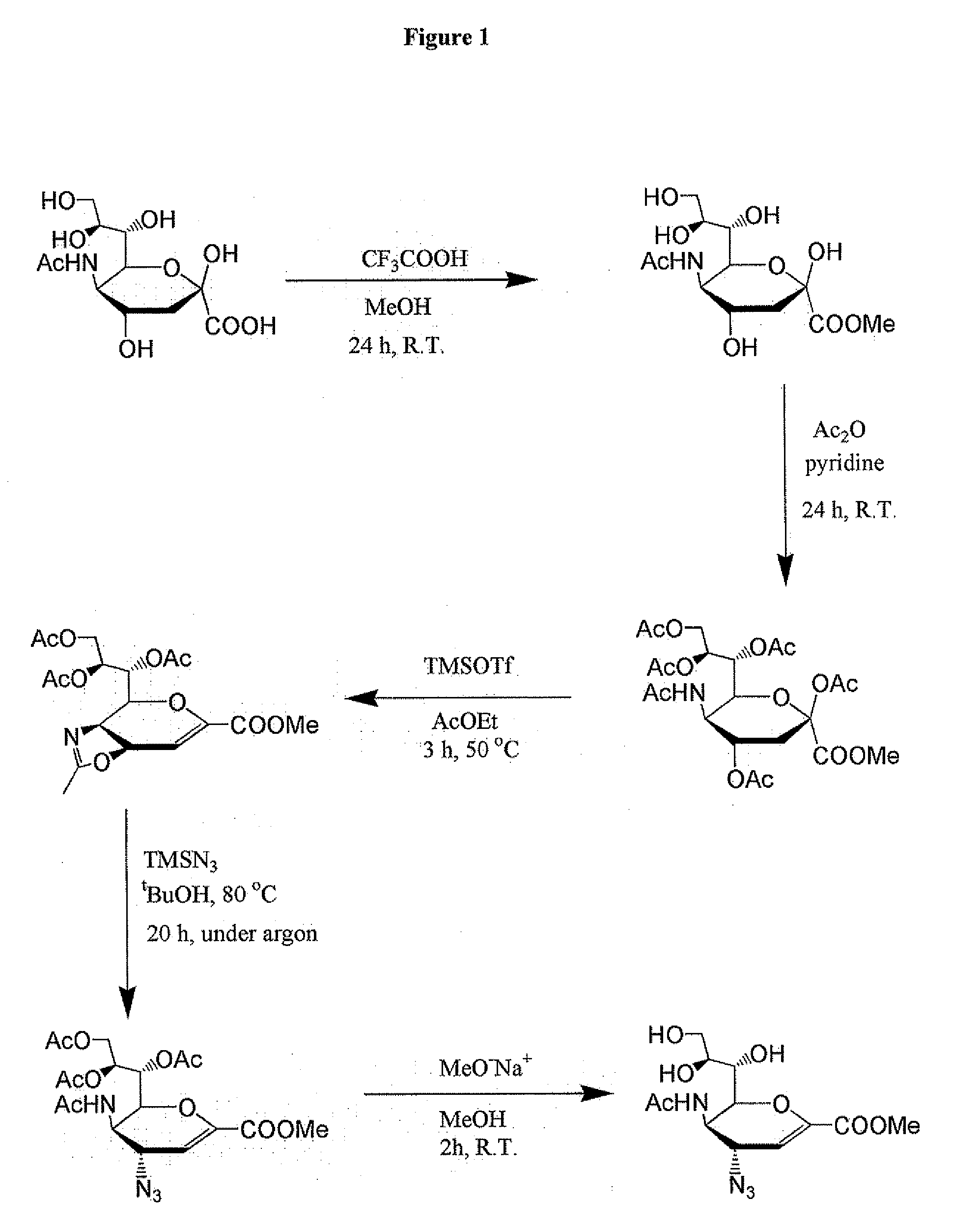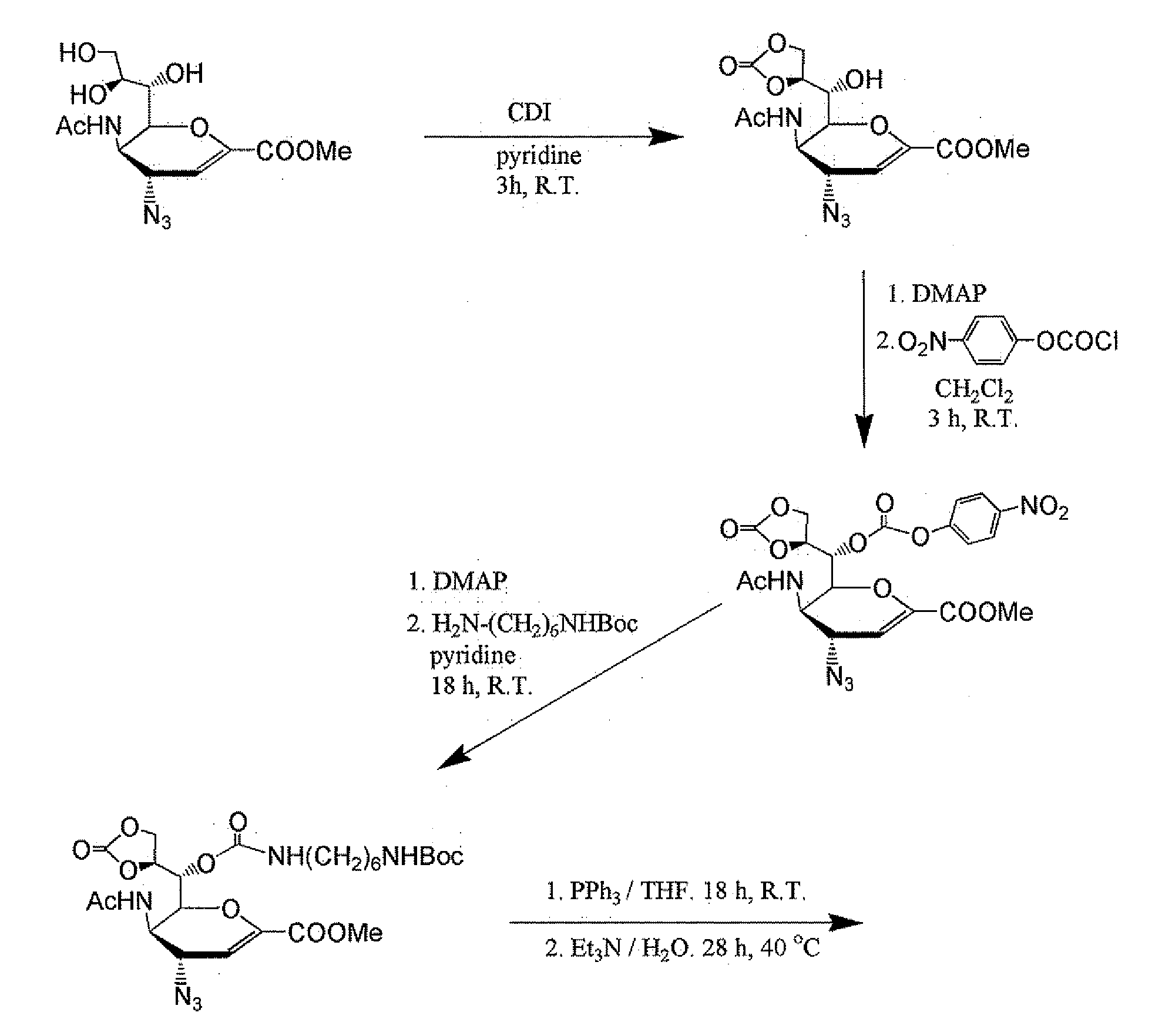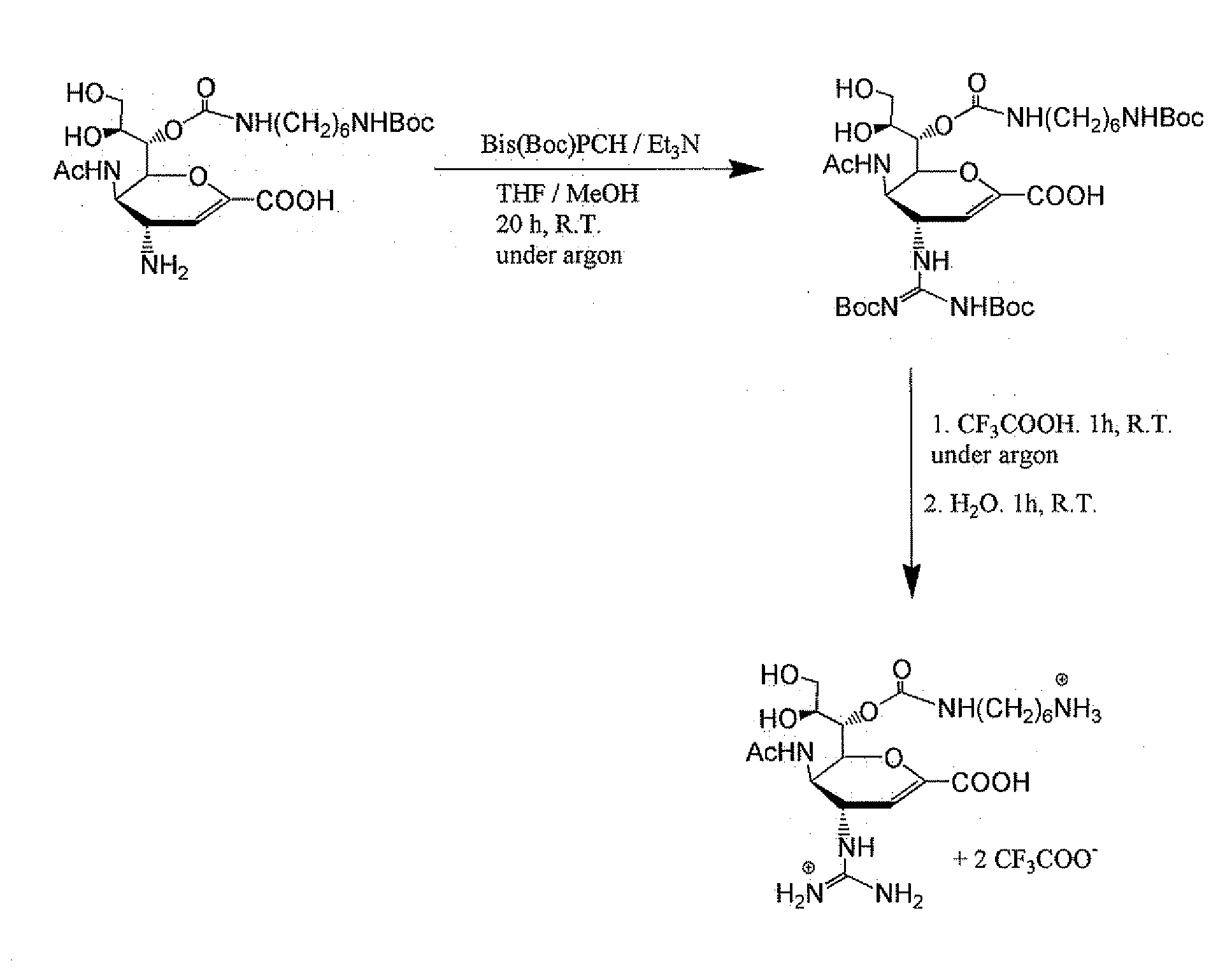Bi-Functional Polymer-Attached Inhibitors of Influenza Virus
a technology of polymer-attached inhibitors and influenza viruses, which is applied in the field of polymer compositions, can solve the problems of ineffective drugs, limited protection of vaccination, and enormous suffering of patients, and achieve the effect of inhibiting or preventing the development of resistan
- Summary
- Abstract
- Description
- Claims
- Application Information
AI Technical Summary
Benefits of technology
Problems solved by technology
Method used
Image
Examples
example 1
Synthesis of Poly(isobutylene-alt-maleic anhydride)-Zanamivir (PIMBA-ZA) Conjugates
[0064]Synthesis of Zanamivir Derivatives
[0065]The monomeric zanamivir analogue was synthesized using the following published procedures with some modifications: a) Chandler, M., M. J. Bamford, R. Conroy, B. Lamont, B. Patel, V. K. Patel, I. P. Steeples, R. Storer, N. G. Weir, M. Wright, and C. Williamson. 1995. Synthesis of the potent influenza neuraminidase inhibitor 4-guanidino Neu5Ac2en. X-Ray molecular structure of 5-acetamido-4-amino-2,6-anhydro-3,4,5-trideoxy-D-erytro-L-gluco-nononic acid. J. Chem. Soc. Perkin Trans. 1:1173-1180. b) Andrews, D. M., P. C. Chemy, D. C. Humber, P. S. Jones) S. P. Keeling, P. F. Martin, C. D. Shaw, and S. Swanson. 1999. Synthesis and influenza virus sialidase inhibitory activity of analogues of 4-Guanidino-Neu5Ac2en (Zanamivir) modified in the glycerol side-chain. Eur. J. Med. Chem. 34:563-574. The synthesis is shown in FIG. 1.
[0066]Synthesis of PIMBA-Bearing Zanami...
example 2
Antiviral activity of PIMBA-ZA conjugates
[0069]To determine the antiviral activity of PIMBA-ZA, plaque reduction assays were performed. The assay was conducted by mixing 125 μl of ten-fold series dilutions of the inhibitors with an equal volume of influenza A / Victoria / 3 / 75 (H3N2) in phosphate-buffered solution (“PBS”) (800 plaque forming unit (pfu) / mL). Following incubation at room temperature for one hour, 200 μl of the reaction mixture was added to confluent Madin-Darby canine kidney (“MDCK”) cells in 6-well cell culture plates and incubated at room temperature for one hour. After incubation, the solution was removed by aspiration. The cells were then overlaid with 2 ml of the F12 plaque medium and incubated at 37° C. for 3 days. The cultures were fixed with 1% formaldehyde for one hour at room temperature, the cells were stained with a 1% crystal violet dye solution, and the plaques were counted. As controls, no inhibitor, monomeric zanamivir derivative, or bare PIMBA were used. ...
example 3
Synthesis of Poly(isobutylene-alt-maleic anhydride)-sialic acid (PIBMA-SA) conjugates
[0071]Synthesis of an O-Glycoside of Sialic Acid
[0072]Sialic acid was coupled to a linker using the following published procedures: a) Baumberger, F., A. Vasella, and R. Schauer. 1986. 4-methylumbelliferyl 5-acetamido-3,4,5-trideoxy—D-manno-2-nonulopyranosidonic Acid: Synthesis and Resistance to Bacterial Sialidases. Helvetica Chimica Acta 69:1927-1935, b) Warner, T. G., and L. Laura. 1988. An azidoaryl thioglycoside of sialic acid. A potential photoaffinity probe of sialidases and sialic acid-binding proteins. Carbohydrate Research 176:211-218. c) Byramova, N. E., L. V. Mochalova, I. M. Belyanchikov, M. N. Matrosovich, and N. V. Bovin. 1991. Synthesis of sialic acid pseudopolysaccharides by coupling of spacer-connected Neu5Ac with activated polymer. J. Carbohydr. Chem. 10:691-700. The synthesis is shown in FIG. 3.
[0073]Synthesis of Polymers of O-Glycoside of Sialic Acid
[0074]Conjugation of the O-gl...
PUM
| Property | Measurement | Unit |
|---|---|---|
| Percent by mass | aaaaa | aaaaa |
| Percent by mass | aaaaa | aaaaa |
| Percent by mass | aaaaa | aaaaa |
Abstract
Description
Claims
Application Information
 Login to View More
Login to View More - R&D
- Intellectual Property
- Life Sciences
- Materials
- Tech Scout
- Unparalleled Data Quality
- Higher Quality Content
- 60% Fewer Hallucinations
Browse by: Latest US Patents, China's latest patents, Technical Efficacy Thesaurus, Application Domain, Technology Topic, Popular Technical Reports.
© 2025 PatSnap. All rights reserved.Legal|Privacy policy|Modern Slavery Act Transparency Statement|Sitemap|About US| Contact US: help@patsnap.com



